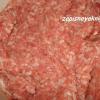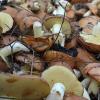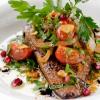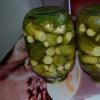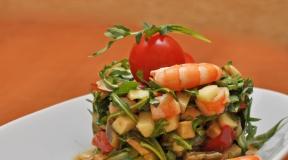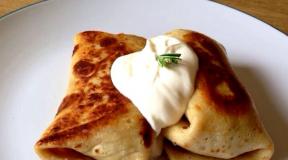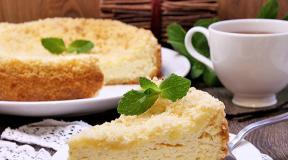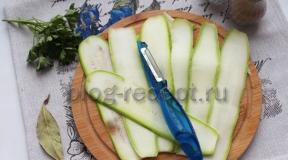The main producers in the confectionery market. Publishing house "Sphere": How is the situation with prices on the market? Which of the confectionery products has risen in price more than the others? Confectionery Market: Development Forecast
THE DRINKS
DROP YOUR WONDER THAT IS NOT BOUND BY DEAL!Prospects for the development of the Russian wine market
WELL, FOR STABILITY!Overview of the Russian beer market
TEA. COFFEE
PAD VS CAPSULESOverview of the Russian coffee market
CONFECTIONERY
OUR WOMEN ARE THE MOST RUMWE DO NOT GO INTO THE FOREST FOR RED BERRY
Overview of the Russian jam market
Protein muffinsMEAT AND MEAT PRODUCTS
BY SUPPLY AND FOODOverview of the Russian meat market
FISH
NO FISH, ONE POLLACKOverview of the Russian market of fish and fish products
MILK PRODUCTS
How we create new yogurtsBACK IN THE USSR!
Overview of the Russian Dairy Market
GIVE ONLY A TIMEWays to stimulate sales of goods on the verge of expiration date
INGREDIENTS
EVEN THE BLUE SEA WILL DOWNOverview of the Russian market of starch products
CATERING
AND IN THE RESTAURANT, AND IN THE RESTAURANT, AND THERE ARE GUITARS, AND THERE THE GYPSIES…Overview of the Russian restaurant market*
FINANCE AND CREDIT
FIRST THING, FIRST THING - AIRCRAFTEXHIBITIONS
TNA Food Processing and Packaging Innovation22nd international exhibition "Agroprodmash-2017"
4th International Exhibition ANUFOOD China-2017
34th International Food and Beverage Exhibition Anuga-2017
International exhibition of technologies for the production of beverages and liquid products Drinktec-2017
26th International Food Exhibition WorldFood Moscow
NEW IN THE INDUSTRY
NewOUR WOMEN ARE THE MOST RUM
Overview of the Russian confectionery market
Research of the news agency "Credinform"
DOMESTIC PRODUCTION VOLUME
The Russian confectionery market is one of the world's largest markets. It has a wide range of products famous brands. Key foreign manufacturers are building or acquiring production facilities in the Russian Federation to increase business profitability. Domestic companies also have a rich history and culinary traditions in abundance.
At the end of 2016, 3,569 thousand tons of various confectionery products were manufactured in Russia, which is 2.1% more than in 2015 (rice. 1 ) . And if we compare last year's figure with the level of 2010, then the increase in domestic production will be 23.5%.
Over the past 3 years, the production of confectionery products has been growing at a not as significant pace as it was before 2014, which is explained by a general decline in consumer demand caused by a drop in real disposable incomes of the population, an increase in prices for key raw materials - cocoa beans. It is worth noting that at the end of 2016, the decline in prices for cocoa beans began. However, as a rule, companies create inventories, especially for raw materials that can be stored in warehouses for a long time. Most likely, domestic companies were purchased at prices that were significantly higher than today.
MARKET STRUCTURE
The confectionery market is divided into 2 large groups(segments):
* sugary - berry products, caramel, dragees, chocolate, and products based on cocoa powder, sweets, toffee, halva and oriental sweets types of caramel and sweets;
* flour - cookies, gingerbread, waffles, muffins, rum women, rolls, flour oriental sweets, cakes, pastries. In turn, the category of flour confectionery products is usually divided into long-term and short-term storage products. In the first case, many preservatives and substitutes are used for its manufacture.
Confectionery products based on cocoa and chocolate form 49.4% of the market in real terms (rice. 2 ) . Sweet biscuits and gingerbread, waffles, long shelf life cakes form a share of 40.5%. Cakes, pastries and other non-durable flour confectionery products account for the remaining share of the domestic market, equal to 10%.

PRODUCTION DYNAMICS BY MAIN SEGMENTS
The production of chocolate-based confectionery reached its historical peak in the modern history of Russia in 2014 - 1,759 thousand tons (rice. 3 ) . In 2015, there was a slight decrease in the indicator, and at the end of 2016, there was a slight increase.

The reason is quite obvious: the devaluation of the ruble with a simultaneous rise in prices for primary raw materials - cocoa beans, increased the costs of companies, there was an increase in prices, there was a decrease in demand, which ultimately resulted in the stagnation of the chocolate industry.
Long-term storage flour confectionery, on the contrary, demonstrates a steady positive dynamics of production indicators. If we compare the results of last year (1436 thousand tons) with the level of 2010, then the increase will be 30.9%.
Demand for non-durable confectionery products (cakes, pastries) is stable. The output of sweets in this category in 2016 slightly exceeded 356 thousand tons.
FOREIGN TRADE VOLUME
After analyzing the foreign trade turnover, we can state with all confidence that Russian confectioners almost completely satisfy domestic demand, and also successfully supply their products to other countries. With the exception of cocoa beans, domestic suppliers can offer all primary raw materials for the production of sweets.
In 2016, the volume of imports of confectionery products amounted to 162 thousand tons, and 339 thousand tons were sent for export, with a domestic production volume of 3569 thousand tons. (rice. 4 ) . Thus, in physical terms, the share of imports in Russian stores does not exceed 5% with a total market volume of 3392 thousand tons. Based on these data, it can be established that the consumption of sweets in Russia per capita is 23.1 kilograms per year.

The main foreign trade partners for the import of confectionery products to Russia are the EU countries, primarily Germany, Italy and Poland. The Top 5 importers also include partners in the EAEU - Belarus and Kazakhstan. Together, these countries account for 60% of all supplies (tab. 1 ) .

Ukraine lost the Russian market almost completely: if in 2013 the share of products from this country reached 33%, then in 2016 it decreased to a modest 1.6%. In total, in 2016, confectionery products were imported to Russia from 79 countries of the world.
The export of sweets from Russia, despite all the difficulties, remains quite stable - in 2016 it amounted to 339 thousand tons, and the fall in purchase prices (due to the devaluation of the ruble) for foreign counterparties made domestic products more competitive in foreign markets.
Russia's main export partners are the EAEU member states: Kazakhstan (26.3% of deliveries in physical terms), Belarus (13.8%), and China (10.4%). Together, these 3 countries account for 50.5% of total domestic exports (tab. 2 ) .

The share of the EU countries in the total volume of exports of Russian confectionery products remains insignificant - about 4% in physical terms. In total, the export of Russian products in 2016 was carried out in 78 countries of the world, up to such exotic states as, for example, Somalia, Algeria, Tunisia, Chile and others.
PRICES
Considering the average retail prices that have been established for the main types of confectionery products throughout the country, we can trace some stabilization of the situation, especially after the surge in inflation in 2015-2016. The exception is chocolate, the price of which continues to rise, but not at such a rapid pace. The reason lies in the unfavorable world market for cocoa beans, and the domestic producer is completely dependent on this raw material.
In June 2017, a kilogram of chocolate in Russia cost an average of 836 rubles. (rice. 5 ) . Chocolate sweets were sold at 591 rubles per kilogram, cakes at 431 rubles, and gingerbread at 127 rubles.

The limiting factor for further price growth is the decrease in the purchasing power of the population.
MANUFACTURERS
According to the information and analytical system GLOBAS ® of the Information Agency "Kredinform", among the manufacturers of confectionery products, one can single out the Top 10 working on Russian market the most successful companies in terms of annual sales revenue. The key players here are: Nestle Russia LLC, Mars LLC and Mondelis Rus LLC (tab. 3 ) . The three leaders firmly hold their positions in the Russian confectionery market in industrial scale. The companies have organized their own production within the country and produce products under well-known and recognizable world brands.

Separately, it is worth mentioning OOO Fazer, which shows a significant decrease in annual revenue due to the high import content for the main food ingredients, which led to a significant increase in costs. Thus, in today's economic conditions, those players who did not have time to localize production as tightly as possible and organize supply chains directly in Russia noticeably lose.
Almost all Russians, in one form or another, pamper themselves with all sorts of sweets. Today, the confectionery market is undergoing a transformation: the Ukrainian manufacturer has completely left, the supply of imported products from other countries has significantly decreased. The devaluation of the ruble gives an excellent chance for domestic companies to both aim to expand their presence in neighboring countries and open up new areas for the sale of products that are almost as good as European ones in terms of quality.
Anton Shcherbakov,
expert of IA "Credinform"
The segment of flour confectionery products in Russia is at the stage of saturation. To increase demand, enterprises update production, give the product a corporate identity, and create new types of products. To date, there is a tendency to complicate products, since flour confectionery, on the one hand, is a product of almost everyday demand, and at the same time, on the other hand, a product for pleasure. Increasingly, there are “specialized” products, such as lean products and sweets. different cuisines world, which have steadily occupied their niche in the Russian market.
by the most popular view flour products is biscuits. On average, about 4.5 kilograms of this product per person is consumed in Russia, that is, in our country only 645,750 tons of cookies are eaten per year, and almost half of this volume falls on residents of the largest cities.
The share of cookies within this segment is estimated by a number of experts and researchers in different ways and varies from 30 to 60%. The question is which categories should be included in the category of flour confectionery products when evaluating the market, and which regions are we talking about. If we talk about the largest cities of Russia and the most popular types of flour confectionery products in them, then cookies look like the most attractive segment - it occupies 60% of the market volume among such competitive groups as gingerbread, which occupy 16% of the market volume, cakes and pastries 8% , muffins and biscuits 7%, and waffle cakes only 4% of the market. Figure 1 shows the structure of the flour confectionery market in 2013 in real terms.
Fig.1
As can be seen from Table 6, oatmeal and sugar biscuits are in the greatest demand on the market of flour confectionery products - they account for 18.6 and 18.3% of total consumption, respectively.
The Russian confectionery market is dominated by domestic producers. However, the share of foreign products is gradually increasing: in 2012 it amounted to 12.3%.
Table 6
Distribution of market shares by types of biscuits, % of average consumption
|
Types of cookies |
Market shares by consumption, % |
Market shares of packaged products by consumption, % |
Market shares of bulk products by consumption, % |
|
Sugar |
|||
|
Curd |
|||
|
Sweet stuffed |
|||
|
Other butter |
|||
|
Dry type "Maria" |
|||
|
multilayer |
|||
Traditionally, the largest share in the structure of imported flour confectionery products is occupied by Butter Cookies. This category includes gingerbread, biscuits, sandwich biscuits and chocolate biscuits. In the first half of 2013, the share of imports of sweet butter biscuits amounted to 37.3% of the total supply of flour confectionery products in physical terms (Fig. 2).

Rice. 2
For comparison, the volume of import purchases of long biscuits (crackers, biscuits) amounted to only 4.5%. The second place in terms of supply is occupied by cakes and desserts - these sweets account for 22.8% of total imports. It should be noted that about 8% of imported cakes and desserts are frozen products. Waffles close the top three (including wafer wafers and wafer cakes), the share of imports of which is 12.9%. The “other” category includes cakes, shortcakes, rolls, muffins, buns, donuts, gingerbread, semi-finished products, ready-made breakfasts, crackers, dryers, tartlets and some other types of flour confectionery.
More than 38% of flour confectionery products that entered the territory of our country in the first half of 2013 were produced at enterprises in Ukraine, which is traditionally the largest supplier of these products to Russia (Fig. 3).

Rice. 3
Germany accounts for 16% of imports in monetary terms, followed by Italy with a 15% share of imports, followed by Poland, the Netherlands, the Republic of Korea and France, with shares ranging from 7 to 2% of total imports. The remaining share of 18% is distributed among 43 countries.
On the Russian side, the regional structure of imports of flour confectionery products is represented by 46 regions. The leader in purchases is the Vladimir region, whose market share is 28% in value terms, or 10.9 thousand tons worth $ 44.2 million (Fig. 4).

Rice. 4
The leadership of the region is due to the fact that two large importers are located on its territory: CJSC Ferrero Russia, which ranks first among Russian importing companies, and LLC Mondelis Rus, which owns the third place. The fourth part of the market (9.6 thousand tons worth $38.4 million) is occupied by Moscow - the metropolitan region occupies the second place in terms of direct import deliveries. The Kursk region also entered the top three regions importing flour confectionery products with a share of 12% (9.2 thousand tons worth $ 18 million) due to the location of CJSC Konti-Rus located in the region - the enterprise ranks second among importing companies .
It should be noted that in the first half of 2013 purchases were made by 529 organizations. However, 51% of the market was occupied by six companies (Fig. 5).

Rice. 5
Russian wafers and wafer cakes were in the highest demand among foreign companies, their share in the sales structure amounted to 40.3% (Fig. 6).

Rice. 6
The second place in terms of sales was sweet butter cookies - this type of confectionery accounted for 32.8%. Rolls and other confectionery products account for 22.9%.
Ukraine, the leader in the supply of flour confectionery products to Russia, occupies a leading position in the purchase of these products - it owns 20% of exports (Fig. 7).

Rice. 7
Azerbaijan and Brazil rank second and third with shares of 17% and 16%, respectively. Equal shares are occupied by Mongolia and Kyrgyzstan - these countries each own 8%. Tajikistan and Georgia account for 6% and 4% of exports, respectively.
In a detailed examination of the export structure of sweet biscuits, it can be noted that half of the deliveries are biscuits coated with chocolate icing or containing cocoa. The second place in the export structure of sweet biscuits is occupied by sugar biscuits, whose share is 42.4%. The main supplies of these cookies are directed to neighboring countries - Kyrgyzstan, Azerbaijan, Tajikistan and Georgia. The third place in the structure of exports is shared by sandwich biscuits and butter biscuits - they account for 3.5 and 3.2%, respectively. The main producer of sandwich biscuits is Konti-Rus, while more than 40% of butter biscuits are produced by OAO Orkla Brands Russia.
In total, in the first half of 2013, 276 Russian enterprises were engaged in the export of flour confectionery products. The share of the leader - Nestle Russia LLC (Samara region) accounts for 25% of exported products.
During the period under review, this company sold 3.7 thousand tons of KitKat wafers for the amount of $16.3 million. The second place among exporting enterprises was taken by Mars LLC (Moscow region) with a share of 9%. This happened due to the fact that Twix biscuit sales amounted to $ 5.8 million. Closes the top three exporters-leaders LLC Chipita St. Petersburg, which owns 6% of deliveries worth $ 3.6 million. The products of this company are recognizable under TM 7 -Days. (Fig. 8).

Rice. eight
Summing up, it can be noted that in recent years there has been a tendency to increase the volume of imports and exports of flour confectionery products, the structure of imports and exports is changing, new players are emerging. By 2015, from the point of view of the prospects for joining the WTO, the duty rate on imported flour confectionery products will be reduced from 15 to 10%. It is expected that there will be more goods, and prices will decrease. In terms of exports, positive changes are also possible. Russian manufacturers will increase supplies, improve quality and sell more products abroad.
The biscuit segment can be divided into two groups, which differ greatly both in price and in their structure - these are loose and packaged biscuits. In fact, these are two different markets. The main difference between these two groups is the price difference (loose biscuits are much cheaper) and the absence of a single Russian leader offering its products throughout Russia in the loose biscuit segment. In each region, the largest part of the market is occupied by local producers. On the whole in Russia, sales volumes of loose biscuits are higher than those of packaged biscuits, and, according to experts, they account for about 60% of the total volume. The main advantages of bulk biscuits: affordable retail price, the possibility of any weight when buying, the ability to visually verify the quality and freshness of the product. Such a product does not require special advertising.
With packaged biscuits, the situation is somewhat different. The success of small bakeries in local markets is due to greater flexibility in production capabilities and the ability to meet rapidly changing consumer needs. In recent years, there has been an increase in the share of packaged biscuits and a decrease in the share of loose biscuits. The reason for this is the increasing role of modern retail, namely self-service supermarkets.
Packaging for cookies can be very different - cardboard, film, and even quite expensive tin are used. When creating their own packaging, which would make it possible to distinguish a product on the market and draw the attention of consumers to it, manufacturers conduct marketing research and test - polls of focus groups. On the one hand, Russian consumers, in their own words, are attracted by bright, stylish, original packaging. On the other hand, everyone remembers the Soviet times very well, when placer cookies had high palatability and immediately it was possible to accurately assess its freshness and safety.
That is why many manufacturers produce packaged cookies in a transparent film - the only accent on such packaging is the bright logo of the company. But such a cookie should really attract attention and be original in itself.
The market for packaged biscuits is more concentrated than for loose biscuits - ten manufacturers account for up to 70% of total sales, and it is in this category of biscuits that there is increased competition among manufacturers. In the segment of packaged biscuits, the importance of the brand and the structuring of the price offer come to the fore. Traditionally, the biscuit market is dominated by products of the lower price segment - mainly due to sales volume in capacious regional markets. However, analysts say that the niches of the middle and lower price segments in the biscuit market are approaching saturation.
The segment of expensive cookies is growing, the segment " healthy foods”, enriched with vitamins, low-calorie foods etc. The production of complex types of biscuits is increasing. All this is accompanied by the introduction of memorable brands to the market and the proposal of product concepts. Such reactions of manufacturers are caused by a change in the culture of consumption of confectionery products in general - consumer demand is gradually restructuring towards more quality products, aesthetically designed and functional.
The price factor in packaged biscuits is less significant, since packaged biscuits are oriented towards more affluent segments of the population compared to loose biscuits, the consumer is ready to pay extra money for the brand.
The distribution of sales between varieties of cookies depends on the region, on the size of the city and its distance from the federal center. Usually in big cities consumers have more choice and they prefer something “original”. But mostly Russians prefer sweet biscuits, whose share in total sales is about 50%.
The share of complex biscuits in the sales of packaged products is still lower, which is largely due to the high price of this product. In general, prices for biscuits have a wide range, which is due to the presence of a large number of different varieties of biscuits. The assortment range presented in stores is very wide.
Today, an increasing number of packaged and branded products from small local manufacturers appear on the market. Last but not least, this is due to the requirements imposed on products by chain stores, and the fact that with today's abundance of various sweets, it is no longer profitable to produce “just” cookies. Moreover, for a successful new product launch, products must be produced under well-known and/or heavily advertised brands.
For example, the Bezhitsky Food Processing Plant (Bryansk) has released an original line of crackers under the trade mark Pikantel, which includes items such as Pikantel with Basil, a fragrant cracker with a piquant taste of basil and delicate aroma cheese and "Pikantel with pizza flavor", which has the taste of classic pizza.
Today, many manufacturers find some kind of "zest" on which they can successfully focus the attention of consumers and push them to the necessary associations.
Thus, in 2008 the Sladkaya Sloboda company (city of Kirov) produced biscuits "Derevenskoye Glazed" in a colored flow-package weighing 285 grams. The manufacturer drew the attention of buyers to the fact that the biscuits are made from village milk, which is associated with naturalness, environmental friendliness and health benefits.
A popular recent marketing move by Russian companies is the positioning of their products as goods for fasting people. For example, the Confectionery Association "Lubimiy Krai" (Leningrad region, the city of Otradnoye) in 2008 developed lean products for the beginning of Lent. The company produced oatmeal and butter cookies under the Stuchki and Posidelkino brands.
Another trend is the growth in sales of complex confectionery - cookies covered with chocolate, or products with filling, such as cookies with marshmallows, cookies with marmalade. The buyer likes interesting products, so any unusual solutions from manufacturers are in high demand among the consumer. Most major manufacturers have such products in their product portfolio.
The Harris company produces BisQuick sandwich biscuits with various fillings: vanilla, strawberry, cocoa, " boiled condensed milk". The confectionery factory "Bolshevik" produces both biscuits with fillings and glazed biscuits.
The assortment of the factory includes Yubileinoye cookies covered with milk or chocolate icing, Prichuda cookies with various fillings (apricot, orange, cherry, pear, strawberry jam, caramel soufflé) and covered with dark chocolate icing, as well as Prince biscuits in the form of a sandwich with nut, chocolate and milk fillings.
The Orion company specializes in the production of complex cookies. The most famous are chocolate-coated biscuit cookies with Choco-Pie mashmallow cream filling and shortbread in the form of a mushroom with a hat made of Choco Boy chocolate.
Experts see the need for constant expansion of the range of manufacturers. Confectionery is the segment in which the consumer has less strong preferences and is more willing to experiment and try everything new.
In the packaged biscuit market, the following companies can be distinguished among the main Russian manufacturers:
JSC "Bolshevik" (Moscow) is a leading manufacturer and distributor of confectionery products. The trademarks of this company include "Jubilee", "Barney", "Tornado", "Shokobarokko". Bolshevik is one of the largest manufacturers of packaged biscuits in Russia (its market share is 30-40% of 40% of total packaged biscuit sales). Among the main brands of sugar biscuits, the highest growth in market share was recorded by the most expensive brand - "Yubileynoye" with icing.
Research results show that 97% of the Russian population knows the Yubileinoye brand, 50% of consumers prefer Yubileinoye to other brands.
United Confectioners Holding is the largest confectionery holding in Russia, uniting more than a dozen food industry enterprises in Moscow and many regions from St. Petersburg to Blagoveshchensk. Among the holding's assets are the most famous and oldest Moscow confectionery factories - Krasny Oktyabr, Rot Front and Babaevsky Confectionery Concern, founded in the 19th century.
The enterprises of the holding own the most recognizable and popular confectionery brands in Russia and the CIS, under which almost all types of confectionery products are produced: chocolate and bars, consumer and premium candies, various types of cookies and biscuits, marmalade, marshmallows and other sweets. Rot Front, Krasny Oktyabr and Babaevsky are included in the list of Top 40 Most Expensive Brands in Russia (according to Interbrand Zintzmeyer & Lux AG).
United Confectioners Holding successfully competes in the Russian market with transnational corporations Nestle, Mars and Kraft Foods. Products are sold through a developed distribution network throughout Russia, as well as in the USA, Europe, Israel, the CIS countries and a number of Middle East countries. Among the permanent consumers of the holding's products are the Federal State Unitary Enterprise "Kremlevsky" food plant, the Government of Russia, the Moscow Mayor's Office and the Moscow Patriarchate.
The Russian holding company United Bakers (Voronezh) is the largest Russian manufacturer of crackers, biscuits and extrusion products, owns 38% of the Russian cracker market, 7.5% of biscuits, 23.5% of the production of extruded finished products, 90% of semi-finished products for the confectionery industry .
The company owns registered trademarks:
Lyubyatovo is Russia's leading brand in the segment of ready-to-eat extrusion products.
"Yantar" - popular varieties of cookies, united under the umbrella brand of a major manufacturer.
"Udivlyandiya" - extrusion breakfasts for children.
"Fanteks" - extrusion semi-finished products for use in the food industry. They are used in the manufacture of premium sweets, chocolate and ice cream from well-known Russian and foreign manufacturers (Cadberry, Nestlé, Craft Foods, Korkunov and others).
Confectionery Association "SladCo" is one of the largest manufacturers of confectionery products in Russia. The association is one of the five leaders in the confectionery industry and produces all the main types of confectionery: chocolate, sweets, caramel, cookies, waffles.
SladCo is a company with national distribution, whose products are presented throughout Russia from Khabarovsk to Kaliningrad. SladCo products are also present in the CIS countries. In 2005, the company was acquired by the Norwegian concern Orkla. At the moment, SladCo is a company with foreign capital (100%).
The confectionery association is presented in three main categories:
1. Chocolate (candies in boxes, chocolate bars, bars, candies by weight, packaged candies by weight);
2. Flour confectionery (cookies, waffles, waffle cakes, crackers);
3. Caramel (by weight, packaged).
Currently, SladCo products are manufactured at two production sites: in Yekaterinburg; in Ulyanovsk.
Product quality and consumer interests are an absolute priority for the company.
The Lakom Group is a large Russian trade and production holding in the confectionery sector. The head office is located in St. Petersburg, production sites are located in St. Petersburg and the Leningrad region. The holding's production capacities allow to produce up to 60,000 tons of confectionery products per year. The Lakom group of companies occupies 10% of the sugar biscuit market in Russia. Distribution of products from factories belonging to the Lakom group covers all federal centers and the largest cities of Russia.
The holding includes "First Biscuit Factory", "Golden Key (confectionery factory)", "PK" Ladoga ", as well as a company with the same name -" Lacom ". The assortment of the group consists of various types of cookies, waffles, marshmallows, marmalade and has more than 500 items.
By the nature of production, sugar cookies are the most common today. The predominance of sugar biscuits in the market is explained by the peculiarities of its production, since high-performance conveyor lines are used in its manufacture, while in the production of the so-called jigging biscuits (typical representatives are kurabye, glagolitic, etc.) small-scale production is used (up to 1.5 thousand kg per shift). That is why there is a predominance of only a few trademarks of sugar biscuit manufacturers, the most famous of which is Bolshevik OJSC. At the same time, the production of jigging biscuits remains the lot of small and medium-sized businesses. The share of dry biscuits (typical representatives are crackers) is not very large. A number of experts attribute this to some monotony of this type of cookie.
Filled biscuits have not yet won a worthy place among other varieties. This is due to a small supply of this type of biscuit and, accordingly, weak demand, as well as the fact that the technique that allows it to be made has appeared relatively recently, it is quite expensive and is not yet very common in the industry.
Manufacturers tend to place visual information about the additives contained in cookies on the packaging, applying images of nuts, chocolate, lemon, grapes, etc. This allows the customer to accurately identify the right flavored cookie on the counter without having to read the ingredient information. The optimal weight of a biscuit package for individual consumption is 200 g, for family (collective) consumption - 400-500 g. It is this weight range that retail outlets strive for when self-packing weight biscuits.
As a rule, the buyer prefers medium-sized biscuits, as they are contained in the package in larger quantities, which is relevant for collective consumption. Some manufacturers, when it is difficult to visually determine the quantity of the product, indicate on the package not only the weight, but also the number of pieces in one package, thereby protecting the biscuits from damage as a result of attempts by consumers to determine the quantity using the "probing" method.
Summarizing the analysis of the domestic market of flour confectionery products, it should be noted that the production of biscuits is growing every year, and the number of domestic biscuit manufacturers is also growing. Manufacturers are looking for new niches for this market. The niche of the so-called office cookies is considered relevant. Now this market niche is filled exclusively with imported biscuits - only they correspond to the "premium class" category.
The niche of packaged biscuits in large packages (250 - 300 grams) is practically free - a kind of table biscuit for the whole family, designed for daily mass consumption.26
Currently, the Russian biscuit market continues to develop, but in many respects its development begins to slow down the negative trends regarding the growth of the welfare of the population. In the future, the growth of the biscuit market will continue, however, it will be characterized by increased competition, the emergence of new players and new, more sophisticated types of biscuits, an increase in the role of quality and appearance manufactured products.
At present, the Russian confectionery market is conditionally represented by two large commodity groups: 1) cocoa, chocolate and sugary confectionery products, 2) flour confectionery products. The first group includes caramels, dragees, glazed sweets, chocolate and chocolate products, toffee, halva, marmalade and pastille products, oriental sweets and other sugary products. The second group includes cookies, biscuits and crackers, gingerbread and gingerbread, cakes, pastries, muffins, waffles and other flour products.
According to the results of the first half of 2016, the share of the first group in physical terms is 47.8%, the share of the second is 52.2%. Based on the available data of Russian statistics, the division by segments can be conditionally represented as follows (Figure 1): gingerbread and similar products, sweet biscuits, wafers account for the largest market share - 41.7% of the total production volume, cocoa, chocolate and sugary confectionery products (excluding caramel, other chocolate sweets) - 31.1%.
Figure 1. The structure of the confectionery market by volume of manufactured products in physical terms in the first half of 2016,% of the total weight
In the structure of the largest commodity group, the largest share belongs to sweet liver (Figure 2). The segment occupies 48% of all manufactured products of this category. The second position is occupied by wafers and wafer wafers with a share of 16.7%, the third - gingerbread (13.1%). The share structure was built following the results of 2015. In general, compared with 2014, it has not undergone significant changes. Chocolate candies with a share of 22.4% occupy a leading position in the product group "Cocoa, chocolate and sugary confectionery products" (Figure 3). The second place is occupied by chocolate and food products containing cocoa (except for sweetened cocoa powder) with a share of 14.0%. On the third - caramel (12.1%), including candy caramels, with chocolate icing and various fillings. The share structure was also built following the results of 2015. In general, compared with 2014, it has not undergone significant changes.

Figure 2. The structure of the largest segment of the confectionery market in terms of production volume in physical terms at the end of 2015,% of the total weight

Figure 3. Structure of the “Cocoa, chocolate and sugary confectionery” segment in terms of production volume in physical terms at the end of 2015,% of the total weight
The production of confectionery products, despite the difficulties of the economic development of Russia, shows an increase from year to year. At the end of 2015, more than 3.4 million tons of confectionery products were produced, while the increase compared to 2014 was 1.2%. Compared to 2010, the volume of confectionery production increased by 20% (Figure 4.). Of course, consumer demand contributed to the growth of production indicators. Even in the last three years, starting from 2014, when the overall purchasing power has declined due to a significant weakening of the ruble, the consumer has remained true to himself, and no upheavals have weakened his love for tasty and sweet. Therefore, if in 2010 consumption in Russia was 20.5 kg of confectionery products per capita, by the end of 2016 consumption is expected to exceed 23 kg.

Figure 4. Trend diagram of confectionery production in physical terms for the period 2010–2015 and 2016 (estimated value).
It should be emphasized that manufacturers themselves also influenced the increase in demand by introducing new and expanding the range of attractive confectionery products to the market. Sellers also make their contribution by improving the marketing system and product promotion technologies. In addition, niches are being vacated due to a decrease in the supply of imported products. According to the results of 2016, the import of confectionery products to Russia in physical terms will be lower than the results of 2015, when it did not exceed 150 thousand tons and amounted to only 4% of the total supply of the studied products on the Russian market.
Significant in the Russian confectionery market is the fact that, starting from 2013, the export component in physical terms began to exceed the import, in monetary terms (meaning dollars) - since 2014. Thus, the balance of trade turnover of confectionery products has acquired a positive value. However, in 2016, the volume of export deliveries from Russia is also expected to decrease in physical terms compared to 2015, when exports exceeded 300 thousand tons and amounted to only 9% of the total volume of confectionery production. In general, in 2015, imports of confectionery products to Russia in physical terms decreased by 2.3 times compared to 2013, in 2016 the decrease will increase to 2.5 times.
In monetary terms, imports in 2015 decreased by 2.2 times compared to 2013, in 2016 the decline will increase to 2.8 times. The decrease in exports of confectionery products from Russia in physical terms in 2015 compared to 2013 amounted to 1.1%. The same value of the drop in supplies will be typical in 2016. In monetary terms, the figures for the volume of export supplies from Russia will decrease respectively in 2015 by 1.5 times, in 2016 - by 1.7 times. As can be seen, the values of import and export deliveries do not significantly affect the volumes of the Russian confectionery market, because they are insignificant against the background of production volumes. According to experts of the Information Agency "Credinform", in 2015 the volume of the market in physical terms approached 3.3 million tons. In 2016, it is expected to reach 3.4 million tons.
In monetary terms, in 2015 the market volume reached the following results: in dollar terms - 19.5 billion in ruble terms - 1.2 trillion. In 2016, with an average annual exchange rate of 65 rubles per 1 US dollar, the market volume may exceed 20 billion dollars, or more than 1.319 trillion rubles. With an average annual exchange rate of 70 rubles per 1 US dollar, it will be about 19 billion, i.e. lower than in 2015, or 1.318 trillion rubles. Thus, in 2016, the market volume in ruble terms will exceed the figure for 2015 at any of the above average rates.
At the end of 2015, according to the Globas-i Information and Analytical System, the top three manufacturers in terms of sales revenue are: Nestlé Russia LLC, Moscow; LLC "Mars", Moscow region; OOO "Mon'delis Rus", Vladimir region (see table 1). Comparison of revenue with the market volume allows us to determine the shares of leaders in the market at the end of 2015: 10.2; 8.0; 5.0% respectively. Representatives of the top ten are also presented in the table.
Table 1. The largest manufacturers in the confectionery market by sales revenue in 2015
| | Name | Revenue, billion rubles, 2015 | Increase / decrease in revenue, % | Market share, % |
| 1 | OOO Nestle Russia, Moscow | 120,46 | 23,6 | 10,2 |
| 2 | LLC "Mars", Moscow region | 93,95 | 16,9 | 8,0 |
| 3 | OOO "Mon'delis Rus", Vladimir region | 58,58 | -6,5 | 5,0 |
| 4 | CJSC "Ferrero Russia", Vladimir region | 33,62 | 14,7 | 2,8 |
| 5 | NJSC "Wrigley", St. Petersburg | 19,86 | 2,9 | 1,7 |
| 6 | PJSC "Moscow confectionery factory "Red October" | 12,24 | 22,2 | 1,0 |
| 7 | NJSC "Konti-Rus", Kursk region | 11,86 | -1,2 | 1,0 |
| 8 | PJSC "Rot Front", Moscow | 11,86 | 15,3 | 1,0 |
| 9 | PJSC "Confectionery Concern "Babaevsky", Moscow | 9,85 | 10,1 | 0,8 |
| 10 | Perfetti Van Melle LLC, Moscow region | 8,95 | 282,7 | 0,8 |
According to the results of 2016, in the absence of serious problems in the global economy, we should expect an increase in the production of confectionery products in physical terms according to the basic forecast scenario at the level of 3%, in the short term, the increase in the indicator will continue within 1–3%. The volume of the confectionery market in terms of money according to the basic forecast scenario may grow in 2016 compared to 2015 by 11–12%.
In the next 2–3 years, if the price growth trend continues, the increase will vary within 4–8%. The market will be positively affected by continued consumer demand. At the same time, there are fears that the uncontrolled rise in prices for confectionery products may still affect this trend. Prices may also be boosted by new rules for the trading industry that came into effect in July 2016 as a result of amendments to the trade law. According to them, the bonus paid by the supplier to the retailer should not exceed 5 percent, and the terms for deferring payments to retail chains have also been reduced.
For sellers, this situation will be unprofitable, as the amount of payments received from suppliers decreases. In addition, an increase in the costs of concluding and executing contracts with manufacturers and suppliers is expected, since retailers must conclude new supply contracts subject to the adopted amendments, and old ones must be brought into line with the new requirements by January 1, 2017. As a result, lost revenues, as well as additional costs will be transferred to the cost of the goods, which may lead to its rise in price.
Confectionery market: Due to falling incomes and the devaluation of the ruble, Russians reduced their consumption of chocolate products in 2015, but began to eat more cookies, gingerbread and waffles, according to Nielsen research company.
In the category of confectionery in 2015, sales of chocolate fell the most, according to the data of the Nielsen Russia research company provided by RBC. Compared to 2014, sales of chocolate products decreased by 3% in physical terms, which is explained by rising prices and a decrease in the purchasing power of Russians. “Chocolate is not an essential item, so its consumption is declining,” explains Sergey Glamazda, director of the food market group at Nielsen Russia. This statistics is confirmed by the international research company Euromonitor International. According to its data, sales of chocolate and chocolates in Russia in 2015 in physical terms decreased by 3.1%, to 716.6 thousand tons.
According to the Center for Confectionery Market Research (CCR), the consumption of chocolate products fell even more - by 8.4%, to 3.99 kg per person per year. The executive director of the CCR, Elizaveta Nikitina, explains this by the fact that, first of all, Russians refuse expensive, in particular imported, products. In 2015, imports of chocolate and products containing cocoa fell by 27.6%, according to calculations by the Moscow World Trade Center based on statistics from the Federal Customs Service.
The fall in demand for chocolate turned out to be beneficial for manufacturers of flour confectionery products: sales of cookies, gingerbread and waffles increased in 2015 by 6%, 7% and 9% respectively in physical terms, according to Nielsen data. In monetary terms, sales of biscuits increased by 21%, gingerbread by 24% and waffles by 25%.
Changes in Russian preference are explained by the price factor, says Glamazda. According to Rosstat, a kilo of biscuits in Russia in January cost an average of 140 rubles, gingerbread - 118 rubles, and chocolate and chocolates - 752 rubles. and 570 rubles. respectively. The growth rates of prices for chocolate and chocolate products during the year were noticeably higher than for gingerbread and biscuits. While chocolate rose by an average of 33.5%, the cost of gingerbread rose by only 16%.
The increase in sales of long-term shelf-life confectionery products was also confirmed by RBC by the main owner of Lyubimy Kray Confectionery Association JSC (manufacturer of cookies and gingerbread under the Posidelkino and Posidelkino trademarks). Orange sun”) Dmitry Kostygin. The largest producers of chocolate and chocolates in Russia are United Confectioners (TM Krasny Oktyabr, Rot Front and Babaevsky), Mars Inc (Mars, Snickers, Twix, Milky Way, Dove, Korkunov, etc.). ), Ferrero Group (Ferrero Rocher, Kinder) did not respond to requests from RBC.
Analysts at Nielsen also note a significant increase in retail chain private label biscuit sales. In 2014, private brands of retailers in terms of sales in real terms overtook the market leader for the first time - the Yubileinoye brand of the international company Mondelez Int. According to Nielsen, in 2014 the share of private labels was 18.7% against 15.8% for Yubileiny. In 2015, retailers' products already accounted for 21.1% of the market, while Yubileiny's share decreased to 15.6%. A representative of Mondelez did not answer questions from RBC. “Russia is a critically important market for us, in the top ten, and in the categories of biscuits and chocolate, it is one of the most important countries for us,” said the head of Mondelez Int. Irene Rosenfeld in an interview with RBC in November 2015.
Confectionery market.
I want to note the serious changes in the Russian confectionery market, which have affected me, my family, and have not passed by each of you and your loved ones. These changes open up new opportunities, and it is precisely today that the confectionery store as a business is promising and timely. What are these changes, why a small business in the confectionery industry gets new chances for development, we will understand in a detailed article.
The history of the confectionery business spans over 20 centuries. The first merchants of sweets arrived in the territory of modern Europe from the east as early as the 6th-5th century BC. Primitive lollipops, simple baking, cottage cheese and sugar baklava were on the tables of the ancient nobility. In the Middle Ages, spices were brought to Europe from India and chocolate from South America. It was a revolutionary moment in the history of the confectionery business.
In France, coffee shops and chocolate shops were opened, in England, scones (a kind of cupcakes), popular to this day, appeared. Russian pretzels and pies also aroused interest abroad. However, to combine cultural traditions, different techniques for making confectionery, textures and completely various ingredients could only by the end of the 18th century, and the next century is considered the birth of world confectionery culinary. France is considered to be its homeland. But there is another, no less popular direction of confectionery art - the eastern one.
It's hard to compare french desserts and oriental delights, baklava and Saint Honoré, Turkish delight and Tiramisu. However, oriental techniques for making sweets have about 40% of fans all over the world, so you can’t ignore them.
Consumer demand for sweets has been at a high level for almost 300 years. Moreover, the change in market conditions is obvious: if back in the 1920s gingerbread and cakes were bought as a festive attribute, now the culture of consumption of sweets brings sweet dishes into everyday consumption.
We regularly see pastry shops and coffee shops on the streets offering wide range of complex and simple sweets. Strudels, cheesecakes, brownies, muffins, cupcakes are waiting for us at gas stations, in the halls of business centers, in parks and theater buffets, in street stalls and even McDonald's. Confectionery products from the group of elite privileged products have moved into the category of fast food.
But even this serious market change is not the root cause for a new round of development in the small business segment. The fact that cakes and pastries have become the usual affordable “fast food” for every day has led to their reduction in price at the expense of quality. Instead of butter confectioners use spreads instead of vegetable fats- animal or synthetic, etc. This makes the cost of the product lower, which allows you to survive in the competition.
The main features of the confectionery market in Russia
Russian confectionery environment, thanks to the fundamental school Soviet Union, has a good qualitative theoretical and practical base. However, due to the closeness of Soviet policy, a moment of flexibility was lost. Now the dynamics of development of the domestic confectionery is significantly lower than the Western one. However, if we compare the quality of in-line products, then even taking into account the trend towards cheaper products, the products of our, Russian companies, can be called tasty and edible, which, alas, cannot be said about many European goods (let me emphasize, we are not talking about private confectionery shops yet).
Features of the Russian confectionery market are:
- short term of realization of products;
- the complexity of large-scale logistics and long-distance delivery;
- great amount types and subtypes of products;
- complete dependence of producers on the quality of raw materials from suppliers (ingredient products);
- consumption tradition home baking;
- a wide selection of authentic, local raw materials for fillers (berries, fruits, nuts;
- tight competition in the niche of inexpensive confectionery products and low competition in the segment of natural, high-quality, expensive products;
- the prevalence of small businesses in the segment of fresh baked goods.
Now, as mentioned above, the Russian confectionery market is filled with low-quality cheap products, and finding a cake that is tasty, beautiful, and at the same time natural and safe for children's health is almost impossible.
On this dissonance, private traders survive who make cakes to order, small mini-bakeries, private pastry shops that work for 1-2 cafes or a couple of shops. Therefore, now the confectionery shop as a business is interesting and has a good prospect of income.
Experts comment on the market:

Alto Consulting Group in its study of the Russian confectionery market focuses on the constant and non-stop growth of piece goods turnover. Number of items. produced on the territory of the Russian Federation is growing, consumption too. However, compared to the increase in prices in 2013, the current market, despite major changes in the ratio of currencies, has remained virtually unchanged. The quality of the ingredients is reduced, due to this, the retail price of a confectionery product, instead of a natural increase, is kept at the same level.
And now let's take a closer look at the prices themselves, broken down by the federal districts of Russia:

This picture demonstrates a hypothesis stating that the reduction in quality and cost of production releases a niche for high-quality fresh baked goods and / or complex confectionery products with a short shelf life. This is exactly the segment in which small businesses can thrive. We have already considered how to open a pastry shop or pastry shop from scratch in one of the articles, so we will not dwell on this moment, but will limit ourselves to the statement that this business is now promising in a number of ways:
- large manufacturers work for the shaft, so they strive to maintain maximum sales times, which cannot be achieved using exclusively natural ingredients;
- the need for high-quality, natural and safe goods, especially in the segment of children's products, remains more and more unfulfilled;
- The market requires great flexibility from manufacturers, the ability to follow fashion and capture changing taste preferences, which large factories and concerns cannot technically implement or do it very clumsily and for a long time.
Here is evidence of a change in the structure of demand, as can be seen from the graph below, an increase in the production of cakes and pastries that are not durable

Rice. 2. The number of tons of products by types of confectionery products produced in Russia for the period 2010-2013. Dynamics of market development in unit equivalent.
How the confectionery business works: a description of business models and a brief market analysis
As in any other segment, in the confectionery business there are several models that are implemented for the purpose of making a profit:
Model 1: Manufacture and sale of own products through a network of branded stores and / or contractors (a striking example is the Krasny Oktyabr Confectionery Factory, Moscow). The advantage of this model is direct communication with the consumer, and the disadvantage is high economic risks.
Model 2: Manufacture of products under the order of contractors (this is how the Lironas Confectionery Company, the Volga region, works). Plus models in reduced costs for the sale of products. but the downside is. that the manufacturer actually cannot track the buyer's reaction to a change in the assortment portfolio, prices. quality and does so through focus groups and research. which is also not cheap.
Model 3: Manufacture of products and sale through franchised customers. In this case, the manufacturer sells his products in stores operating under his trademark, for example, the Medobory confectionery shop, Crimea. The advantage of the model is that there are practically no costs for sales promotion and the creation of a distribution network, and the disadvantage is that the company's reputation cannot be controlled (if any of the franchised clients behaves inappropriately with the buyer, the manufacturer's image suffers).
In other words, you need to separate two business processes:
- production of confectionery products and their sale. There are companies that combine these two processes.
- manufacturing and wholesale, or wholesale and retail. There are enterprises that use only one process in full, and the second - in a truncated one.
Among the largest Russian manufacturers, one can also note the following: confectionery factory KDV Yashkino (Kemerovo region), confectionery group of enterprises "Konti", OJSC Lipetsk confectionery factory "Roshen", confectionery factory "Akkond" (Cheboksary), OJSC "Craft Foods Rus" (Vladimir region), Chipita confectionery factory (St. Petersburg), Galan confectionery factory ( Krasnodar region), OAO ROT FRONT (Moscow).
Important points in the organization of the confectionery business are:
- selection of a niche for the production / sale of products (today the snack group is filled, and an acute shortage is observed in the field of short-term storage cream products);
- selection of a place and competent calculation of the turnover of a confectionery outlet;
- choice of supplier.
It is on the choice of a supplier that I would like to focus attention. When a novice entrepreneur is about to plunge into the confectionery market, it is important for him to get a hot commodity. To do this, you need to understand what kind of products you would like to sell.
Confectionery products are products of daily demand: on average, each resident of Russia in 2012 consumed 23 kg of sweets, of which 12 kg were sugary, and 11 kg were flour products. At the same time, about 18% of sweets are bought in Moscow.
Competition in the Russian confectionery market is high. Today, the industry has about 1,500 organizations in all regions of the Russian Federation and more than 15,000 local confectioneries (Rosstat data). enterprises producing 55 percent of the total annual turnover of products.

The largest segments of confectionery products in the Russian market:
- chocolate candies - 21%;
- all types of cookies (including crackers) - 20%;
- cream products (cakes, pastries) - 8%;
- bar and figured chocolate - 8%.
In the period 2010 - 2014, according to Rosstat, the share of imports is constantly decreasing and before the introduction of the food embargo in August, it was 12.2%. Domestic production, respectively, is about 87.8%. The main suppliers of sugary confectionery products to Russia (sugar products include sweets, caramel, toffee and dragees):

For thirteen years (2000-2013), according to Rosstat indicators, the demand for raw materials such as sugar has been steadily growing, and since sugar is an integral ingredient in confectionery, experts tend to see a direct relationship with an increase in demand for ready-made confectionery. The growth dynamics averages 5% annually. Those. we can say that every year the consumption of confectionery products in Russia increases by 5% (both in value and piece equivalent).

Experts believe that by 2017 the market volume will reach $4.5 billion.
Since confectionery products are not essential products, the demand for them is driven by tradition and external market influences.
The structure of food expenses of an average Russian family includes about 9.5 - 15% of the costs related to confectionery. With the size of the food basket of 1 Russian family (3 people) in the amount of 9.5 thousand rubles, an average of 1,500 rubles is spent on confectionery products per month. If this figure is attributed to the number of households in Russia (52,707 thousand), then we get the nominal market volume: 79 billion rubles per month.
Analysis of the seasonality of the confectionery business
Seasonal fluctuations in demand for confectionery products are an objective reality in all areas of the market. This factor has a significant impact on both sales volumes and their structure. Therefore, a comparative analysis in this industry is most adequately carried out by comparing the same periods of the reporting and last years, since adjacent periods can radically differ in terms of the level of turnover, the structure of sales, depending on the influence of holidays, fasting, the holiday season, the appearance of substitutes (berries, fruits), etc.
Below are the seasonality coefficients calculated on the basis of base December - as the month with the highest turnover in the confectionery industry, due to the pre-New Year mood of the consumer (see Figure 1, Diagram 1).
| Impact on consumer activity | |||||
|---|---|---|---|---|---|
| New Year according to the old calendar | |||||
| Easter, parent's day | |||||
| the appearance of the first seasonal berries |
|||||
| Great demand for berries, fruits |
|||||
| holiday season in coastal and tourist regions | |||||
| September | holiday season in coastal and tourist regions |
||||
| weather demand |
|||||
| New Year, corporate holidays |
Periods with approximately the same level of buyer activity are highlighted with one color scheme.
Thus, the 1st phase of seasonality (orange) is characterized by increased demand, due to the presence of holidays. In this phase, February is weak due to the short monthly period.
Seasonal phase 2 (blue) is characterized by a sharp decline in demand until July, which is associated with Lent, the appearance of cheaper substitutes, and the onset of a warm period. In April, there is a change in the structure of production: the sale of cream products by weight decreases, the sale of flour products (Kulich) increases, which affects the turnover. This phase is most in need of marketing stimulation and maintenance of sales volume.
July (yellow) is a transitional month from phase 2 to phase 3 (green), characterized by a gradual increase in trade and, accordingly, output. According to the seasonality coefficient, it is comparable with the 4th phase (yellow) of consumer activity observed in October, November, where the reverse trend is observed - a decrease in trade turnover and output due to the outflow of tourists from recreational areas, the absence of traditional public holidays until mid-December.
December (red) is the month with the highest turnover in the industry. These seasonal factors are average for the market as a whole.
Small business in the confectionery arena
The implementation of the confectionery business in the segment of private entrepreneurship is, as a rule, a cafe-confectionery. There are few options for implementing this format: a private trader can organize his own small production (confectionery shop for 100-300 kg per day) or purchase finished confectionery products from nearby suppliers.
The advantages of own production are direct contact with the consumer, the uniqueness of the offer and the ability to adapt the assortment to the needs of visitors. However, this is also the difficulty: in order to release a new type of product, the shop must develop technological maps and change the production scheme. These are time and financial costs.
When purchasing products from a large supplier (or several), the exclusivity of the product itself is lost, but the risk of unjustified costs for the creation of production lines is leveled. In addition, this scheme is more quickly paid back.
Therefore, opening a cafe-confectionery should be started with a fundamental decision: we produce it ourselves or we buy finished products from a large manufacturer. If an entrepreneur nevertheless decides to start his own mini-workshop, then here you should take into account the costs of a technologist, shift confectioners, equipment and storage facilities where it will be stored as finished products, and blanks.
It is warehouse storage that is often not provided for by novice businessmen, which leads to enormous problems: products are light, but very voluminous and capricious. For example. to accommodate 20-25 standard cakes, you need a rack with shelves 1.5 * 1.5 m in a cool place with a sanitary permit. And if we are talking about baking, then the cornerstone is the wear resistance of the equipment, since you cannot prepare such products for use.
Benchmarketing: Successful Examples of Implementing a Small Confectionery Business

Foreign models:
Ukraine

An unexpectedly interesting confectionery operates in the small Ukrainian town of Melitopol. Despite the provinciality of the city itself, the confectionery surprises with sophistication, competent products, a wide coffee list and author's recipes:
Coffee house-confectionery "Bourgeois", Melitopol - restaurant project. This is a full-fledged coffee shop with its own confectionery shop. Interesting and refined products, classic interior and at the same time low prices (average bill $10-12).

France

CAFÉ POUCHKINE, Paris - patisserie in the style of an 18th century French palace. Visitors can choose from cakes with cream, honey, berries, fruits, jam, macaroons, custom-made cakes from cream, sweets, powdered sugar. Average bill $5-25




